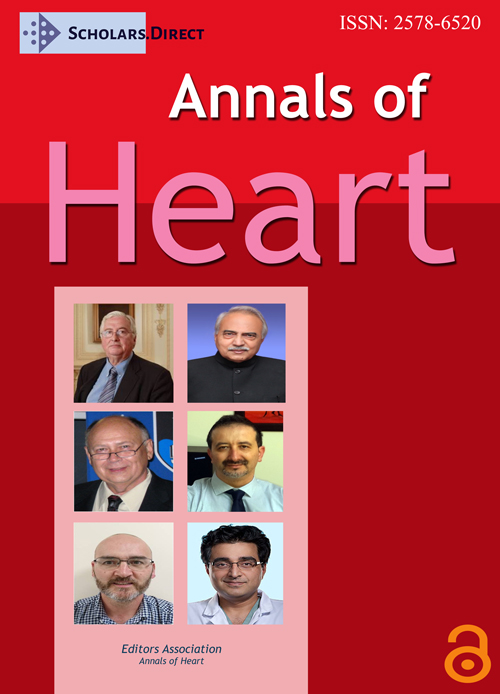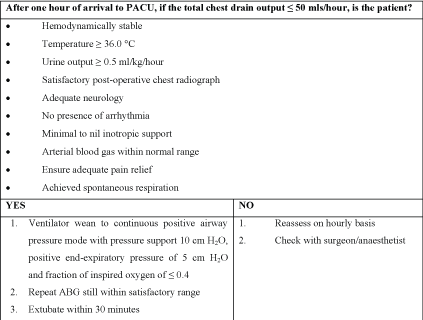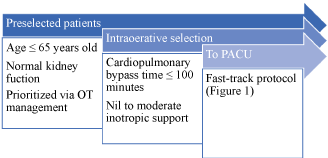Factors Determining Fast-Track Failure Post Cardiac Surgery
Abstract
Background
Fast track protocol has been proven to be cost effective and allows optimal utilization of healthcare services. Careful patient selection is crucial to its success. We aim to identify factors leading to fast track failure in our institution so as to improve patient selection.
Method
We non-selectively enrolled all patients post cardiac surgery that was admitted to PACU in 2015 for Fast-Track protocol.
Results
Through our observational study, we found that older patients, patients with pre-existing renal impairment, at least moderate inotropic requirement on arrival to PACU and total cardiopulmonary bypass time are significant predictors of fast track failure.
Conclusion
As a result, we proposed a more robust Fast-Track model starting from pre-operative patient selection to intraoperative decision before subjecting patients through Fast-Track protocol in order to improve the outcome.
Keywords
Fast-track, Cardiac surgery, Post-anaesthetic care, Critical care
Introduction
Fast-track protocol in selected population is widely recognized as the standard of care by providing patients the benefit of early extubation. It is also proven to be more cost effective and allows optimized utilization of healthcare facility [1-3]. Fast-track protocol in cardiac surgery is gaining popularity after several studies showed that there was no difference in mortality and morbidity between Fast-Track anaesthesia and conventional anaesthesia [3].
Many center's practice Fast-Track protocol in the Intensive Care Unit (ICU). Stefan P, et al. showed that a dedicated Post Anaesthesia Care Unit (PACU) for Fast-Track protocol provide a reduction of total ventilation time and bypassing ICU admission [4]. The postulated reason behind this may be due to a better doctor-to-patient ratio in a dedicated PACU setting.
The Department of Cardiothoracic Surgery, National Heart Centre Singapore has a dedicated PACU for patients post cardiac surgery after moving in to a new building by the end of year 2014. Along with the establishment of a dedicated cardiac PACU, we developed our own Fast-Track protocol with the intention of extubating patients early and therefore bypassing ICU after successful extubation.
The objective of this study was to identify risk factors for Fast-Track protocol failure so as to improve on our current Fast-Track protocol for patients undergoing cardiac surgery. We hope to eventually devise a robust Fast-Track protocol that will allow patients the benefit of early extubation and provide the hospital with an improved utilization of facility and manpower.
Methods
All post cardiac surgery patients in the year 2015 that were admitted to PACU were enrolled into the study non-selectively. Patients were excluded if the team in-charge declined to follow the Fast-Track protocol or if the patients were lodging in PACU while waiting for ICU bed availability.
The PACU operation hours were 7 am till 10 pm, daily from Monday to Friday. There was one doctor stationed in PACU every day with a doctor-to-patient ratio of 1:5 and a nurse-to-patient ratio of 3:2. There were a total of 5 PACU beds.
The Fast-Track protocol is as shown in Figure 1. Once selected, nurses and doctors adhered to Fast-Track protocol and were required to fill up an audit form for each patient admitted to PACU. Information on patient demographics such as age, weight, height, body mass index (BMI) and past medical history was collected. Surgical details such as the type of surgery, aortic cross clamp time and total bypass time were also recorded. EuroSCORE IITM was calculated based on the online calculator provided by the EuroSCORE Study Group 2011.
Reasons for Fast-Track failure were then filled up by doctor-in-charge. After successful extubation, patients will be monitored for an additional hour before being transferred to Intermediate Care Area (ICA, a step-down unit) or ICU, if instructed by primary surgeon for further monitoring. Success of Fast-Track protocol was defined as successful extubation within PACU operating hours.
Data are shown throughout the article as median and interquartile range. Univariate logistic regression analysis using variables identified as risk factors for Fast-Track protocol failure was performed. A multivariate logistic regression analysis using the significant variables identified from univariate analysis was then performed to identify independent risk factors for failure of Fast-Track protocol. Analysis was performed using statistical analysis software SPSS version 23.0 for Windows.
Results
In the year 2015, there were a total of 279 patients admitted to PACU post cardiac surgery. 68.5% of the total study population was able to be extubated within PACU operating hours. Within the successful extubation group, we further classified them into two subgroups: Those able to be extubated within 240 minutes and those requiring more than 240 minutes to be successfully extubated. 31.5% patients failed to be extubated within PACU operating hours, requiring transfer to ICU for further monitoring. This is shown in Table 1.
The patient demographic data was as shown in Table 2. Preexisting renal impairment was defined as creatinine clearance of less than 60 mls/min. Types of surgery shown was divided into three groups: Isolated coronary artery bypass grafting (CABG), isolated valvular surgery and others. Isolated valvular surgery included all surgeries involving single or multiple valves replacement or repair; while others surgery group involved all other cardiac surgeries comprising combined valve and CABG, atrial septal defect closure and pulmonary homograft replacement. Inotropic requirement was divided into three groups: Low (single inotrope of less than 0.05 mcg/kg/hour), moderate (double inotropes which each inotrope was less than 0.05 mcg/kg/hour) and high (any inotrope equal or more than 0.05 mcg/kg/hour). The inotropic requirement was charted as the inotropic requirement upon arrival to PACU. Cross-clamp time and cardiopulmonary bypass time were defined as the cumulative time required in a single surgery.
After performing univariate analysis for the prediction of Fast-track protocol failure, it revealed age, pre-existing renal impairment, EuroSCORE IITM, low and moderate inotropic requirement, aortic cross-clamp time and total cardiopulmonary bypass time as significant predictors (Table 3). In the multivariate analysis, older age (HR 1.054 (1.022 - 1.087), p = 0.01), pre-existing renal impairment (HR 2.786 (1.047 - 7.414), p = 0.04), and total cardiopulmonary bypass time (HR 1.019 (1.002 - 1.036), p = 0.024) were associated with significantly increased Fast-Track protocol failure (Table 4).
Discussion
The Fast-Track protocol that we initially devised followed a simple flowchart and with the intention of extubating patients early in PACU. It was adopted from our own past experience in managing patients post cardiac surgery. We acknowledged that a successful Fast-Track protocol need to be safe for patients, able to achieve targeted extubation within PACU operating hours and most importantly reproducible [5,6].
This study recruited patients based on surgeon and anesthetists' decision to enroll them for Fast track anaesthesia. After introduction of this new pathway, we observed a trend towards certain group of patients. There was a lack of patients with depressed left ventricular ejection fraction (LVEF), pre-existing renal impairment and chronic obstructive pulmonary disease (COPD). This may be contributed by selection bias from the surgical team as these patients are more likely to have post-operative complications like acute kidney injury requiring dialysis, failure of early extubation due to pre-existing lung disease and need for prolonged inotropic support.
Patients successfully extubated were expected to be transferred to ICA. ICA in our institution is equivalent to High Dependency Unit but with the ability to perform invasive pressure line monitoring. However, our ICA was not able to support patients requiring inotropes. If patients failed to be extubated or remained hemodynamically supported by inotropes despite successful extubation, they would be transferred to ICU for further monitoring. This may account for the fact that patients recruited for Fast Track protocol consists mainly of patients with preserved or mildly impaired EF.
Even though patients selected for the Fast Track protocol tend to have preserved or mildly impaired EF, only 68.5% patients were successfully extubated within PACU operating hours. After performing multivariate analysis on all significant risk factors identified from univariate analysis, age, pre-existing renal impairment, inotropes requirement and total cardiopulmonary bypass time were independent risk factors for our Fast-Track protocol failure. The result was consistent with several published studies of Fast-Track anaesthesia [7,8].
A successful Fast-Track protocol allows patients to bypass ICU after cardiac surgery which may translate to a reduction of healthcare cost [9-12]. However, a failure of it may add to the cost instead as they would then be subjected to additional ICU admission on top of PACU admission. Following this study, we would like to propose an addition of patient selection criteria into Fast-Track protocol. The protocol success rate could be improved by excluding patients older than 65-years old, having pre-existing renal impairment, requiring at least moderate inotropic support and total cardiopulmonary bypass time of more than 100 minutes. To further improve the success of the protocol, it would be ideal to pre-operatively identifying such patients and prioritizing them through the operating theatre management. In addition, changing PACU operating time from 7 am-10 pm to 9 am-12 midnight may allow more patients to benefit from this Fast-Track protocol. This led us to propose a new Fast-Track Model as shown in Figure 2.
This observational study is still an ongoing study in our institution. Continuous audit and reevaluation of practice are vital to improving patient care. A follow-up study is necessary to demonstrate the safety of this protocol and how it influences the utilization of healthcare facility, in particular ICU beds and its cost effectiveness.
Conclusion
Careful patient selection for fast track extubation is crucial to its success. Through our observational study, we found that older patients, patients with pre-existing renal impairment, at least moderate inotropic requirement on arrival to PACU and total cardiopulmonary bypass time are significant predictors of fast track failure. Further studies after the implementation of this new selection criteria will help demonstrate the safety of this protocol [13].
Conflict of Interest
There is no conflict of interest.
References
- Cheng DC (1998) Fast-track cardiac surgery: Economic implications in postoperative care. J Cardiothorac Vasc Anesth 12: 72-79.
- Hantschel D, Fassl J, Scholz M, et al. (2009) Leipzig fast-track protocol for cardio-anesthesia. Effective, safe and economical. Anesthetist 58: 379-386.
- Silbert BS, Myles PS (2009) Is fast-track cardiac anesthesia now the global standard of care? Anesth Analg 108: 689-691.
- Stefan P, Chrisof C, Dirk H, et al. (2014) A specialized post-anaesthetic care unit improves fast-track management in cardiac surgery: Aprospective randomized trial. Crit Care 18: 468.
- Hadjinikolaou L, Cohen A, Glenville B, et al. (2000) The effect of a 'fast-track' unit on the performance of a cardiothoracic department. Ann R Coll Surg Engl 82: 53-58.
- Daniel B, Davy C (2015) Early extubation and fast-track management of off-pump cardiac patients in the intensive care unit. Semin Cardiothorac Vasc Anesth 19: 163-168.
- Waseem Z, Jacob L, Sophia S, et al. (2015) Indepenent risk factors for fast-track failure using a predefined fast-track protocol in preselected cardiac surgery patients. J Cardiothorac Vasc Anesth 29: 1461-1465.
- Haanschoten MC, van Straten AH, ter Woorst JF, et al. (2012) Fast-track practice in cardiac surgery: Results and predictors of outcome. Interact Cardiovasc Thorac Surg 15: 989-994.
- Constantinides VA, Tekkis PP, Fazil A, et al. (2006) Fast-track failure after cardiac surgery: Development of a prediction model. Crit Care Med 34: 2875-2882.
- Ender J, Borger MA, Scholz M, et al. (2008) Cardiac surgery fast-track treatment in a postanesthetic care unit: Six-month results of the Leipzig fast-track concept. Anesthesiology 109: 61-66.
- Van Mastrigt GA, Maessen JG, Heijmans J, et al. (2006) Does fast-track treatment lead to a decrease of intensive care unit and hospital length of stay in coronary artery bypass patients? A meta-regression of randomized clinical trials. Crit Care Med 34: 1624-1634.
- Zhu F, Lee A, Chee YE (2010) Fast-track cardiac care for adult cardiac surgical patients. The Cochrane Database Syst Rev 10: CD003587.
- Flynn M, Reddy S, Shepherd W, et al. (2004) Fast-tracking revisited: routine cardiac surgical patients need minimal intensive care. Eur J Cardiothorac Surg 25: 116-122.
Corresponding Author
YC Tham, Resident, Department of Cardiothoracic Surgery, NHCS, 5 Hospital Drive, 169609 Singapore, Tel: +6597230187.
Copyright
© 2018 Tham YC, et al. This is an open-access article distributed under the terms of the Creative Commons Attribution License, which permits unrestricted use, distribution, and reproduction in any medium, provided the original author and source are credited.






